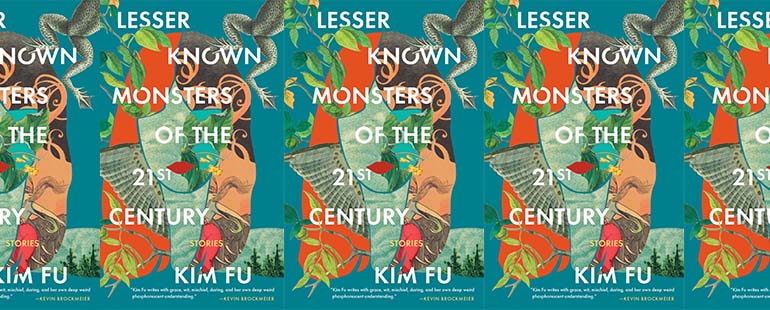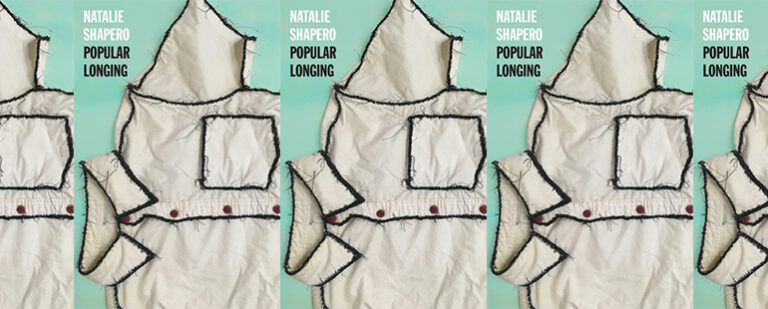Unraveling Reality in Lesser Known Monsters of the 21st Century

Lesser Known Monsters of the 21st Century
Kim Fu
Tin House | February 1, 2022
During the height of the pandemic, a picture circulated on social media of a sign outside a bookstore in Massachusetts that read, “the post apocalyptic section has moved to the current affairs section.” If Kim Fu had published her new short story collection, Lesser Known Monsters of The 21st Century, two years ago, it would have been considered dystopian. But now, in a never-ending global pandemic, everything that we once upheld as tenants of reality has been turned upside down, Fu’s latest collection feels like reality in the waiting.
The stories in Fu’s collection explore technological control, alienation, and the unraveling of reality. The characters are trapped in liminal spaces—a poignant reflection of our current pandemic world. But unlike many of us who crave homeostasis, the characters in the collection embrace the uncertainty of their world. Dystopian elements are consistently infused with emotions and desires we recognize all too well, propelling us to see and accept the gray areas of our world.
The first story, for example, “Pre-simulation Consultation XF007867,” focuses on an unnamed character who wants to spend a simple day with her mother in the botanical gardens, “before she got sick.” The programmer who could create the stimulation denies this request. “But the simulation, you see, requires you to have a firm grip on what is and isn’t real,” the programmer said. “We need clients to make a clean exit, such that the end of the simulation is akin to closing the book, turning off the console, walking out of the theater.” Dreamers visit the Pre-simulation Consultation to experience the unreal and the unattainable—sleeping with a celebrity or experiencing their Broadway directorial debut—dreams so far from the reality that “a clean exit” is possible. The dream simulation provides a temporal sense of happiness and an everlasting addiction to the clients. Many have gone bankrupt just to dream. But in this world of expensive dreams, a gaping hole of loneliness and loss still lurks. It is a reminder that, despite all the technological advances, loneliness will always be part of the human condition.
A similar sense of longing is seen in “Liddy, first to fly”, when the pre-teen titular character is on the verge of a metamorphosis: “A bird’s wing stuck straight out from the side of her leg, the feathers black, the span approximately the length of her hand.” In this Kafkaesque story, Liddy and her friends think her new pair of wings are cool because “the realm of pretend had only just closed its doors . . .” on them, and they hide the transformation from the adults in their lives. The adults have not witnessed Liddy’s transformation because they are committed to a myopic version of reality. The story’s narrator says, “. . . adults can talk to each other until reality straightens, until doubt is crushed, until their memories unstitch and reform. Four adults never see a miracle at once.” Here, Fu suggests that adulthood constricts us from seeing outside the boundaries and facing uncertainty.
A reluctance to see uncertainty is also seen in the story, “Twenty Hours,” when a middle-aged couple purchases an expensive printer that shields them from “certain kinds of death.” It protects the buyers from “accidental death upon impact, an air conditioner to the head, a sixteen-wheeler at high-way speed . . . Swift, cold-blooded acts of violence.” Fu does not describe this futuristic technology but intricately shows how this technological convenience might come at a human cost, unraveling our connection: the couple bought the printer under the guise of saving each other if an accidental death occurs, but in the end, they decide to cause their own—killing each other to escape each other. Here, the truth of their situation becomes clear: they are in a loveless and an unhappy marriage, trying to escape from their miserable lives.
The stories in Lesser Known Monsters of The 21st Century plunge us into radically different worlds and expose the ramification of technological consequences, unrealized dreams, and unmasked contradictions on the individual. What is the verdict? The schism makes the individual disconnected from themselves and their community. Fu doesn’t blatantly give a solution to the problem, but rather suggests that it depends on how many realities we can simultaneously occupy. Worldbuilding of this magnitude often requires pages of descriptions, setting, and plotting to anchor readers, but Fu’s sentences are terse and the stories are more character-driven. The juxtaposition of surrealist elements with reality makes these different worlds appear similar and renders a more fictional quality as opposed to magical realism. Each story feels like a potential episode of Black Mirror, exploring futuristic technology and the dangerous hold it has on all of us. Fu present us with the following question: while technology has added many conveniences to our lives, should we accept it? Should we push back for the safety of humanity?
Fu doesn’t offer concrete answers but instead suggests that with all these technological advances, we remain fragile, lonely, fearful of expressing our own truth, and blinded by our own world view. Herein lies the collection’s hope. The “known monsters of the 21st century” are humans. While they have bleakly accepted things, these humans are dreamers, and encourage each other to be our best. Perhaps, we have not completely collapsed into a dystopian world as yet.


